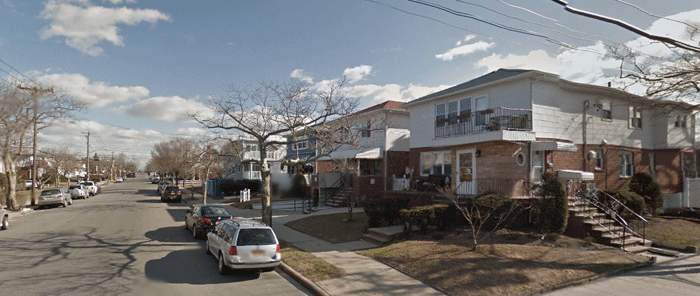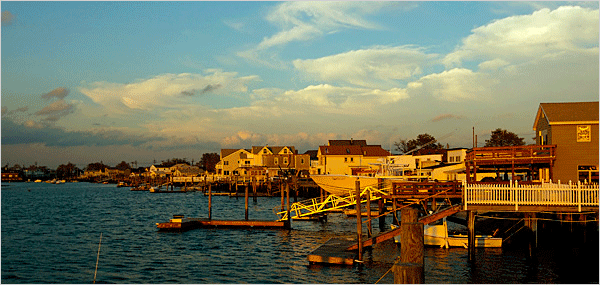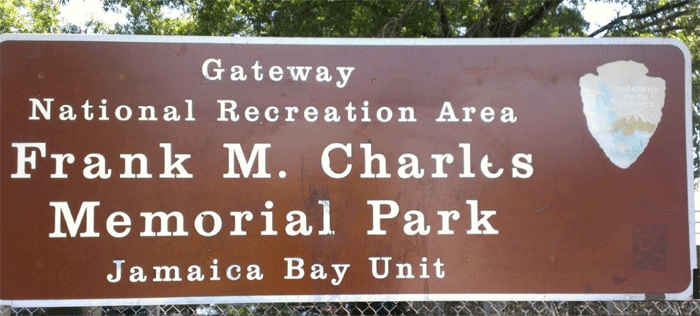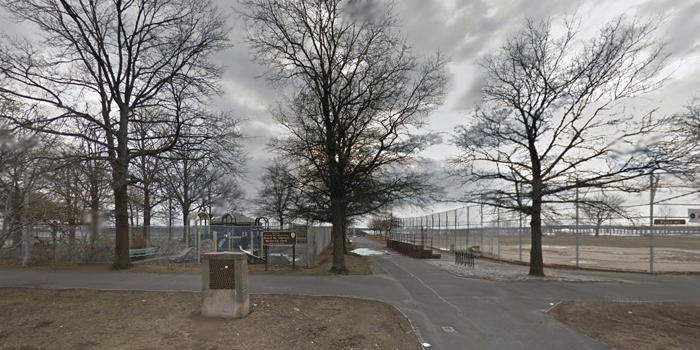By Lee Landor
[Note: This article originally appeared in the Queens Chronicle on June 12, 2008. This content is the rightful property of the Queens Chronicle. Photos were not immediately available.]
The brackish smell rising from the salt marshes of Jamaica Bay wafts over the Cross Bay Bridge and right into the nostrils as one heads south of mainland Queens for a visit in Belle Harbor — one of the most immaculate and tranquil neighborhoods on the Rockaway Peninsula.
Turning onto Beach Channel Drive in the direction of Beach 125th Street — the eastern border of the small, 17-block community — one can see people lined up along the seawall overlooking the Rockaway Inlet, continuously dropping and retrieving fishing lines.
Along the seemingly wide streets of Belle Harbor — made so because of parking regulations that prohibit street parking on weekends and holidays from May 15 to Sept. 30 — children play, couples ride by on bicycles and families stroll lazily in the shade of large, weeping beech trees and looming sycamores.
Out with the old, in with the new
A number of families are part of a wave of newcomers that has engulfed the neighborhood in the last seven or so years — a wave that has managed to bring a fresh quality to the area without changing its dynamic. Younger professionals, mostly upper-middle class with young children, have moved in and replaced the older generation of Belle Harborites, who have moved to neighboring Neponsit, according to the owner of Belle Harbor Realty, Annette Farina.
In her 21 years in the realty business, Farina has witnessed one major change: whereas about two decades ago, people were mostly renting space, today, they’re buying single-family homes that can run from $795,000 to $1 million.
Many of these families come from Brooklyn and parts of Manhattan that have become unaffordable. The appeal of the “hidden treasure” that is Belle Harbor is mostly that it combines affordability and refinement, Farina said. Those leaving Park Slope in Brooklyn or areas like it don’t have to downgrade in order to save some money. They can find the comforts of security and recreation in Belle Harbor.
A main attraction of the neighborhood is its easy access to Rockaway Beach and Jacob Riis Park — which has a large, well-used parking lot for commuters traveling to Brooklyn or Manhattan by car or ferry. In general, the lifestyle afforded by coastal living is desirable because it removes the element of constant stress that sometimes accompanies city life, said Jonathan Gaska, the district manager for Community Board 14.
When mentioned, New York City often conjures up images of fast-walking, fast-talking workaholics who don’t know their neighbors and consider themselves just a face in the crowd of millions milling about the concrete jungle.
This stereotype might be a gross exaggeration, but it is rooted in some truth: many New Yorkers live work-centric lives. But, like life in most beach towns, Belle Harbor living is calm, family centric and community oriented, making this neighborhood the perfect escape.
Selecting superior schools
The real clincher for many newcomers, Farina said, is the quality of Belle Harbor’s schools. Like most young couples starting families, those moving to this neighborhood are thinking about their children’s education and looking to the future; making investments in Belle Harbor property seems to be a smart move in the right direction.
Schools are usually the deciding factor for people trying to relocate: they are an indication of a neighborhood’s quality, Gaska said. “They usually go hand in hand — good schools, and certainly good public schools, keep property values up.”
Belle Harbor is said to possess most of the traits young, well-to-do families look for, from big lawns to quiet neighbors to, most importantly, high-quality schools. This is why, Gaska said, “Belle Harbor is considered one of the premier neighborhoods in the borough.”
The Belle Harbor public elementary school, P.S./M.S. 114, a K-8 located at 134-01 Cronston Ave., is rated one of the best in the school district (District 27), which contains the neighborhoods of Howard Beach, Woodhaven, Broad Channel and parts of Ozone Park, South Ozone Park, Richmond Hill, South Richmond Hill and the Rockaways.
There is also a large selection of parochial schools — which includes St. Francis De Sales (Roman Catholic), West End Temple, Yeshiva of Belle Harbor and Mercaz Hatorah of Belle Harbor — from which parents can choose. For parents with gifted children, there is also the option of The Scholars’ Academy, a school for grades six through twelve, located at 320 Beach 104 Street. The school is “really starting to produce. It’s getting tough to get into, which is a sign that it’s doing really well academically,” Gaska said.
Although limited high school options and no higher learning institutions on the peninsula force teens and young adults to leave the area to complete their education, Steve Kubiak knew he and his wife made the right decision when they decided to move to Belle Harbor when their son was born 11 years ago. Primary education “establishes the roots and values” that help children develop into respectable adults, he said.
To top this all off, property taxes are lower in Belle Harbor than in the Five Towns or other parts of Long Island that might be a logical destination for young city dwellers starting families, Farina said.
Dependable demographics
In its 101 years of existence, Belle Harbor has changed little — and that is what locals love most about it, according to lifelong resident Danny, who did not give his last name. Its steadfast nature has benefitted residents: they have enjoyed the consistent stability of middle-class living — a rarity in most places.
This likely results from Belle Harbor’s mostly unchanging demographic. Since it was founded in 1907 by Frederick Lancaster, its population has been primarily comprised of white, Irish Catholic, working class families, but over the years substantial Jewish and Italian populations grew in the area.
The 2000 U.S. Census bureau lists the population of Belle Harbor and part of Rockaway Park at approximately 11,359. Of this, about 93 percent is Caucasian, and 4,336 are adults between the ages of 25 and 49. Children and young adults up to age 17 make up close to 23 percent of the population, and nearly 3,260 residents are 65 and older.
Belle Harbor is home to a large number of New York City police officers and firefighters, as well, and the neighborhood suffered heavy losses from the Sept. 11 attacks. “It seems like half of the Fire Department and the Police Department lives in the Rockaways,” many in Belle Harbor, according to Gaska who remembers going to funerals every day for weeks following the disaster. “And, so, we lost more people than any other single community.”
Another tragedy struck the neighborhood just two months later, on Nov. 12, 2001, when American Airlines Flight 587, bound for the Dominican Republic, crashed in the center of Belle Harbor shortly after takeoff from neighboring Kennedy International Airport.
The incident, in which 265 people were killed — all 251 passengers and nine crew members on board and five people on the ground — put Belle Harbor’s name on the map, but the negative attention was unwanted. Hoping to maintain their privacy, Belle Harbor families mourned quietly and out of the public eye. The city erected a memorial on Nov. 12, 2006, exactly five years after the tragedy, on Beach 116th Street in neighboring Rockaway Park.
Activities and amenities aplenty
The neighborhood is eerily quiet on a hot Sunday morning: in place of blasting boomboxes and rambunctious beach goers are the sounds of chatting neighbors and water rushing from garden hoses.
One short block mildly disrupts this tranquility: Beach 129th Street. There, “hustle and bustle” is always an applicable phase, as it is Belle Harbor’s small commercial center, which contains a newly opened Dunkin Donuts, Jameson’s Pub, the Plum Tomatoes Pizzeria and the renowned Beach Bagel.
Beach 116th Street — a large shopping center and transportation hub — provides more amenities: department stores, supermarkets and a variety of eateries and smaller shops line the busy street at which the first stop of the A train is located.
Commuting to other boroughs — not a fun task in any part of New York City — was recently made easier for Belle Harbor residents, whose transit options are limited. With the addition last year of the Command bus, which travels directly to Manhattan, and the May 12 launch of the Rockaway ferry, residents can leave the peninsular without their cars.
Close-knit community
Coming into Belle Harbor is a different story. “Outsiders” — those from mainland Queens and other boroughs who visit Rockaway’s beaches — are, for the most part, well-tolerated by Belle Harbor residents, despite the occasional litter they leave behind. But the tight-knit community enjoys its seclusion, according to one resident who did not give his name.
The father of three, who recently moved from another Rockaway location to Beach 134th Street, said it can be difficult for Belle Harbor residents to absorb the hordes of summer visitors. But, they are no more hesitant to let their children play unattended on front lawns. Relying on neighbors for help watching the kids is, and has always been, a big reason for this.
Keith Malucelli shoots hoops outside his Beach 125th Street home. He watches from the corner of his eye as his sons chase each other down the street — Nicholas, 6, on a bicycle and Michael, 4, in a toy truck. Malucelli likes to keep to himself, but his kids eagerly race three houses down to the Kubiak house where 11-year-old Chris and 4-year-old Nicholas slide across the Racer Water Slide their father, Steve, laid out on the front lawn.
There is little worry about outsiders or speeding drivers or aggressive adolescents starting trouble. Few bars, dance clubs, pool halls and bowling alleys on the peninsula lead to a relatively safe, if quiet, existence — but its exactly what these young parents want. It’s the reason Kubiak, originally from Richmond Hill, moved here when his oldest son was born and Malucelli decided to settle down and build a new home six years ago.
“There are very few neighborhoods in this city that are better than Belle Harbor that offer as much at it does,” Gaska said. “It’s one of the top 5 or top 10 neighborhoods as far as neighborhood character, quality of life and market value of real estate — signs of a good neighborhood.”



